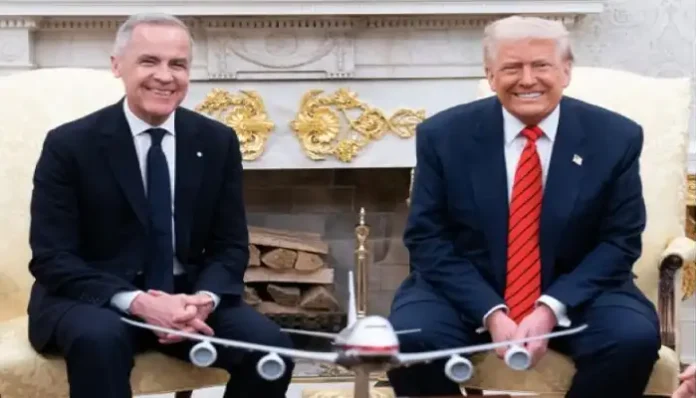WASHINGTON — In a fiery announcement that stunned allies and rattled global markets, former President Donald Trump declared on Thursday that the United States will slap a 35% tariff on all Canadian imports starting August 1, marking a drastic escalation in an already fragile trade relationship. The move threatens to unravel years of economic cooperation between two of the world’s closest trading partners.
“Instead of working with the United States, Canada retaliated with its own Tariffs,” Trump posted on Truth Social, accusing Ottawa of undermining negotiations with aggressive protectionist measures.
From Cold Talks to Full-Blown Trade War
Until this point, Canadian goods not covered under the U.S.-Mexico-Canada Agreement (USMCA)—which Trump had renegotiated during his first term—faced a 25% general tariff, with energy imports levied at 10%.
But relations began to sour in late June when Trump abruptly terminated trade negotiations, citing Canada’s controversial Digital Services Tax (DST) aimed at American tech giants like Google, Meta, and Amazon.
Though Prime Minister Mark Carney backed down and withdrew the tax on June 29, Trump’s latest retaliation suggests the DST may have been only a trigger in a broader agenda.
$410 Billion Relationship on the Line
Trade between the two nations is enormous. In 2024 alone, $410 billion worth of goods flowed north and south across the border, according to U.S. Census Bureau data. Canada remains America’s second-largest trading partner, behind only China, with key exports including lumber, aluminum, automobiles, and oil.
But the stakes are high on both sides. Canada imposed quotas and a 50% surcharge on U.S. steel in response to Trump’s tariff threats, while warning of further countermeasures.
“We are not looking for confrontation, but we will defend Canadian workers from unjust U.S. trade barriers,” said Finance Minister Isabelle Tremblay on Thursday.
A Deal Gone Sour?
What’s puzzling analysts is that just days before Trump’s announcement, sources inside both governments claimed progress had been made.
A phone call between Trump and Carney on June 30 reportedly ended with a joint pledge to pursue a “new era of fair trade” by July 21.
“This 35% tariff feels like a political grenade,” said Laurence Bruckner, senior fellow at the Center for Strategic and International Studies. “Trump appears to be sending a message not just to Canada, but to China, Mexico, and the European Union: get in line or get hit.”
Markets React: Wall Street Slides
The shockwaves hit Wall Street immediately. Dow Jones futures dropped 230 points, while the S&P 500 dipped by 0.5% overnight. Analysts cited the risk of retaliatory tariffs, slowed manufacturing, and inflationary pressure from pricier imported goods.
American automakers, heavily reliant on Canadian parts and raw materials, saw early stock declines in pre-market trading, with Ford and GM both down over 2%.
Fentanyl Link Sparks Diplomatic Firestorm
In an unexpected twist, Trump tied the tariff rollback to Canada’s cooperation in curbing fentanyl trafficking—a problem more commonly associated with the southern border.
“If Canada works with me to stop the flow of Fentanyl, we will, perhaps, consider an adjustment to this letter,” Trump wrote cryptically.
The Canadian government swiftly rejected the fentanyl accusation as “baseless and distracting.”
Political Calculus or Economic Strategy?
Critics say Trump’s 35% tariff is less about trade and more about politics as he ramps up his 2026 re-election bid. By taking a hard stance against foreign competitors, he appeals to his base of blue-collar voters and manufacturing interests, particularly in the Rust Belt.
But the risks are real. A tit-for-tat tariff war with a key ally could raise prices for American consumers, disrupt supply chains, and sour international relations.
“This could boomerang badly,” warned Sarah McBride, a trade attorney with the Global Business Coalition. “Canada supplies everything from electricity to auto parts. Escalation could mean chaos across multiple sectors.”
What’s Next?
Negotiations may continue behind the scenes. Canada’s ambassador to the U.S., Julien Bouchard, confirmed that trade envoys from both sides have been in daily talks aimed at resolving disputes before August 1.
But with Trump’s threats hanging in the air—and the potential for even higher tariffs if Canada “retaliates again”—the outlook remains volatile.
Bottom Line: A trade war is no longer just a threat—it’s here. Whether the damage is short-term political theater or a long-term economic rupture depends on what happens next in Washington and Ottawa.
📌 Editor’s Note: This is a developing story. Follow [LiputanKhususID] for updates on U.S.-Canada trade, global economic impacts, and political fallout.
💬 What do you think of Trump’s new 35% tariff on Canada? Sound off in the comments.


